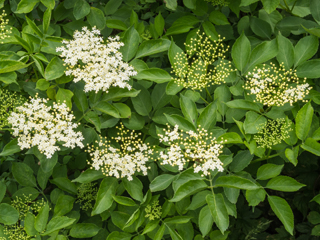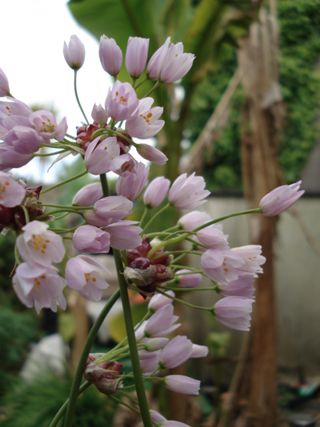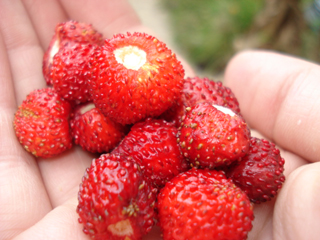 How is it June already?! One of the best months in my opinion (yes I’m a June baby so slightly biased!), but who doesn’t love the heady summer-scented honeysuckle blossoms filling the air, sweet, fragrant roses bursting to life and the creamy elderflower corymbs dotted through every hedgerow. Within the dappled hedgerows the wild garlic has started to go to seed, the wild strawberries are flowering as is the pignut and beautiful delicate pink rosy garlic is filling sunny grass banks.
How is it June already?! One of the best months in my opinion (yes I’m a June baby so slightly biased!), but who doesn’t love the heady summer-scented honeysuckle blossoms filling the air, sweet, fragrant roses bursting to life and the creamy elderflower corymbs dotted through every hedgerow. Within the dappled hedgerows the wild garlic has started to go to seed, the wild strawberries are flowering as is the pignut and beautiful delicate pink rosy garlic is filling sunny grass banks.
As you can guess all the above are edible and some of the best edible treasures. The honeysuckle blossom makes fantastic syrup and liqueur which is like tasting pure summer. Only the flowers can be used when it comes to honeysuckle and no other part as the rest of the plant is toxic. When using rose petals, use any roses but have a nibble on the petals first to see what the flavour is like. Rose petals are perfectly safe to use and my favourite things I use them for are rose petal syrup and rose petal jelly.
 The colour is so pretty especially when you add a squeeze of lemon juice which really ramps up the colour and complements the flavour perfectly. Use the syrup like a cordial, add it to vodka and tonic, drizzle it over cakes, spread the jelly on toast… whatever you can think of, try it as it is so worth it. Later in the year any rose hips can be used to make vitamin C -rich syrup but some are more fiddly than others (and don’t forget to remove the itchy hairy seeds first). I love elderflower so much and you don’t need many flower heads to make cordial, champagne or even liqueur.
The colour is so pretty especially when you add a squeeze of lemon juice which really ramps up the colour and complements the flavour perfectly. Use the syrup like a cordial, add it to vodka and tonic, drizzle it over cakes, spread the jelly on toast… whatever you can think of, try it as it is so worth it. Later in the year any rose hips can be used to make vitamin C -rich syrup but some are more fiddly than others (and don’t forget to remove the itchy hairy seeds first). I love elderflower so much and you don’t need many flower heads to make cordial, champagne or even liqueur.
If you do make elderflower champagne, keep it somewhere contained if possible as the bottles do have a tendency to pop their corks and explode everywhere! We made elderflower champagne for our wedding and it was delicious and actually had more alcohol content than we expected! Perhaps the natural yeast in the flowers develops a stronger percentage the longer you leave it? While we are on the subject of elderflower, one year I got so into making and drinking the cordial, during a trip to the cinema I could smell a fragrance not dissimilar to cat wee… I realised it was emanating from us (if you smell elder blossoms you’ll get what I’m talking about)… we decided to give the elderflower cordial a break!
 With the wild garlic, we have had a great crop of it which just keeps on giving. First we were using the leaves in practically everything – vinaigrettes, on pizza, with scrambled eggs, in pasta, quiche, pesto, the list is endless. The next part you get to relish is the flower buds which are excellent pickled and eaten with cheese, bringing back memories of 80’s dinner parties with cocktail sticks skewering a cube of cheddar and a pickled onion, spiked into a foil-melon ‘hedgehog’.
With the wild garlic, we have had a great crop of it which just keeps on giving. First we were using the leaves in practically everything – vinaigrettes, on pizza, with scrambled eggs, in pasta, quiche, pesto, the list is endless. The next part you get to relish is the flower buds which are excellent pickled and eaten with cheese, bringing back memories of 80’s dinner parties with cocktail sticks skewering a cube of cheddar and a pickled onion, spiked into a foil-melon ‘hedgehog’.
Once the flowers open, try them raw or decorating a savoury dish to give a little garlic hint, then at this stage the unripe green seed pods are perfect for eating raw, adding to dishes or pickling for hot garlicky capers. I’ll be sad to see them die down until next year. With wild strawberries, it won’t be long before we can gorge ourselves on their puny but full bodied fruits (the botanical name is Fragaria vesca – ‘vesca’ means puny due to their size). These make excellent jam and if you are struggling to collect enough, then feel free to add to cultivated strawberries for bulk as the fragrance of the wild strawberry remains, or freeze them until you have enough to make 1 pot.
Summer fruit tarts with rose petal jelly
3 cups scented rose petals
3 cups boiling water
1 tbsp lemon juice
1 ¼ cups jam sugar
Pastry
6 oz plain flour
4 oz butter
2 tbsp cold water
1 tbsp caster sugar
Fruit
Summer berries such as red currants, wild strawberries, blackcurrants, white currants, etc.
Start making the rose petal jelly first by putting the petals in a colander and leaving them for about half an hour so the insects have a chance to escape. Gently wash the petals and put them in a medium sized bowl, pour on the boiling water and cover, leaving them to infuse overnight or at least for a couple of hours.
 Preheat the oven to 180 degrees C. Make the pastry first by combining the flour and sugar, then rub in the butter. This can be done in a food processor. Add the water and this will bring the pastry together. Wrap the pastry in clingfilm, chill for half an hour in the fridge then take it out and roll out on a floured surface so it is roughly a few millimetres thick. Using a cookie cutter that is larger than the diameter holes of a muffin tin, cut out pastry circles and line each divot so the pastry fills each cavity. Bake in the oven for about 10-15 minutes so the shells are cooked through. Take out of the oven and leave to cool completely.
Preheat the oven to 180 degrees C. Make the pastry first by combining the flour and sugar, then rub in the butter. This can be done in a food processor. Add the water and this will bring the pastry together. Wrap the pastry in clingfilm, chill for half an hour in the fridge then take it out and roll out on a floured surface so it is roughly a few millimetres thick. Using a cookie cutter that is larger than the diameter holes of a muffin tin, cut out pastry circles and line each divot so the pastry fills each cavity. Bake in the oven for about 10-15 minutes so the shells are cooked through. Take out of the oven and leave to cool completely.
Once cool add the berries, removing any stalks where necessary. Evenly distribute the berries and fruits amongst the pastry cases. Now continue with the rose petal jelly process.
Pop a small plate in the fridge. Strain the rose water through muslin into a saucepan then add the sugar and lemon juice and heat gently until the sugar is dissolved then turn up the heat and boil. Either use a sugar thermometer – jam is 104 degrees C or test on the cold plate by dropping a little on it, waiting for 10 seconds to let it cool slightly then push it with your finger to see if it wrinkles. At this stage, pour it gently over the fruits in the pastry to coat and to fill. Pop in the fridge to set and serve cold.


